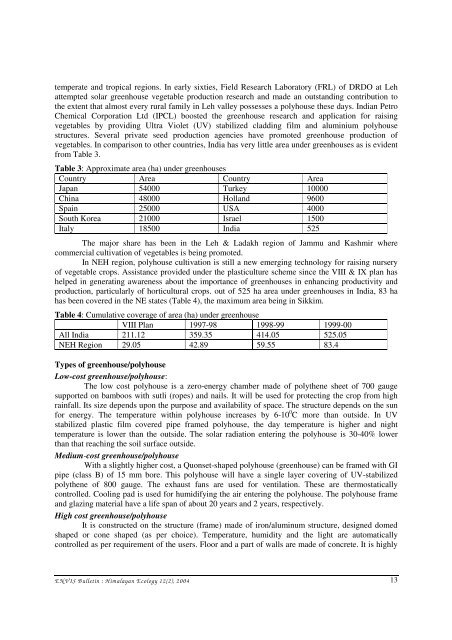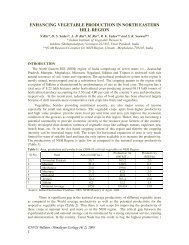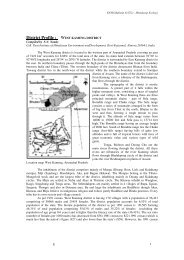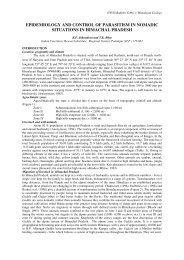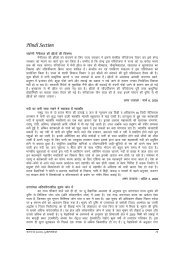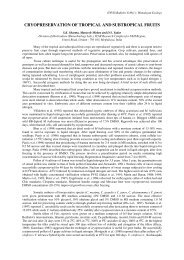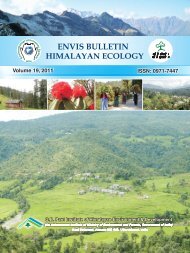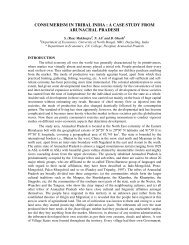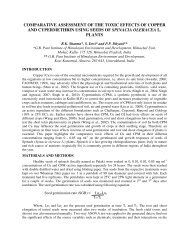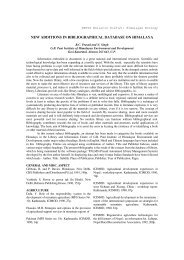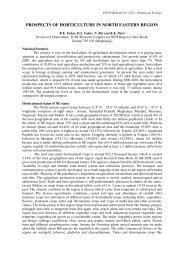ENVIS BULLETIN - ENVIS Centre on Himalayan Ecology
ENVIS BULLETIN - ENVIS Centre on Himalayan Ecology
ENVIS BULLETIN - ENVIS Centre on Himalayan Ecology
You also want an ePaper? Increase the reach of your titles
YUMPU automatically turns print PDFs into web optimized ePapers that Google loves.
temperate and tropical regi<strong>on</strong>s. In early sixties, Field Research Laboratory (FRL) of DRDO at Lehattempted solar greenhouse vegetable producti<strong>on</strong> research and made an outstanding c<strong>on</strong>tributi<strong>on</strong> tothe extent that almost every rural family in Leh valley possesses a polyhouse these days. Indian PetroChemical Corporati<strong>on</strong> Ltd (IPCL) boosted the greenhouse research and applicati<strong>on</strong> for raisingvegetables by providing Ultra Violet (UV) stabilized cladding film and aluminium polyhousestructures. Several private seed producti<strong>on</strong> agencies have promoted greenhouse producti<strong>on</strong> ofvegetables. In comparis<strong>on</strong> to other countries, India has very little area under greenhouses as is evidentfrom Table 3.Table 3: Approximate area (ha) under greenhousesCountry Area Country AreaJapan 54000 Turkey 10000China 48000 Holland 9600Spain 25000 USA 4000South Korea 21000 Israel 1500Italy 18500 India 525The major share has been in the Leh & Ladakh regi<strong>on</strong> of Jammu and Kashmir wherecommercial cultivati<strong>on</strong> of vegetables is being promoted.In NEH regi<strong>on</strong>, polyhouse cultivati<strong>on</strong> is still a new emerging technology for raising nurseryof vegetable crops. Assistance provided under the plasticulture scheme since the VIII & IX plan hashelped in generating awareness about the importance of greenhouses in enhancing productivity andproducti<strong>on</strong>, particularly of horticultural crops. out of 525 ha area under greenhouses in India, 83 hahas been covered in the NE states (Table 4), the maximum area being in Sikkim.Table 4: Cumulative coverage of area (ha) under greenhouseVIII Plan 1997-98 1998-99 1999-00All India 211.12 359.35 414.05 525.05NEH Regi<strong>on</strong> 29.05 42.89 59.55 83.4Types of greenhouse/polyhouseLow-cost greenhouse/polyhouse:The low cost polyhouse is a zero-energy chamber made of polythene sheet of 700 gaugesupported <strong>on</strong> bamboos with sutli (ropes) and nails. It will be used for protecting the crop from highrainfall. Its size depends up<strong>on</strong> the purpose and availability of space. The structure depends <strong>on</strong> the sunfor energy. The temperature within polyhouse increases by 6-10 0 C more than outside. In UVstabilized plastic film covered pipe framed polyhouse, the day temperature is higher and nighttemperature is lower than the outside. The solar radiati<strong>on</strong> entering the polyhouse is 30-40% lowerthan that reaching the soil surface outside.Medium-cost greenhouse/polyhouseWith a slightly higher cost, a Qu<strong>on</strong>set-shaped polyhouse (greenhouse) can be framed with GIpipe (class B) of 15 mm bore. This polyhouse will have a single layer covering of UV-stabilizedpolythene of 800 gauge. The exhaust fans are used for ventilati<strong>on</strong>. These are thermostaticallyc<strong>on</strong>trolled. Cooling pad is used for humidifying the air entering the polyhouse. The polyhouse frameand glazing material have a life span of about 20 years and 2 years, respectively.High cost greenhouse/polyhouseIt is c<strong>on</strong>structed <strong>on</strong> the structure (frame) made of ir<strong>on</strong>/aluminum structure, designed domedshaped or c<strong>on</strong>e shaped (as per choice). Temperature, humidity and the light are automaticallyc<strong>on</strong>trolled as per requirement of the users. Floor and a part of walls are made of c<strong>on</strong>crete. It is highlyE N V IS B ulletin : H im alayan E cology 12(2), 2004 13


